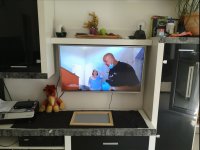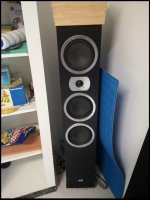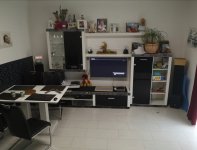Hello fellow DIY-ers!
This is my first thread here on this forum abut the idea I have on this "stereo center speaker".
First of all I have zero knowledge on acoustics and zero experience building speaker enclosures so take it easy on me.
The idea is to have two speaker enclosures in a single unit and place it under my TV
I already have two Markaudio CHR70.3 drivers on hand and also a class D Bluetooth amplifier with line in and a matching power supply that will be placed in the middle compartment of the unit.
All the measurements on the drawing are in millimeters
This is my first thread here on this forum abut the idea I have on this "stereo center speaker".
First of all I have zero knowledge on acoustics and zero experience building speaker enclosures so take it easy on me.
The idea is to have two speaker enclosures in a single unit and place it under my TV
I already have two Markaudio CHR70.3 drivers on hand and also a class D Bluetooth amplifier with line in and a matching power supply that will be placed in the middle compartment of the unit.
All the measurements on the drawing are in millimeters
Attachments
I think you'd be better off building two separate speakers and just laying them on their sides. Then you'd be able to move them into a typical stereo arrangement for music if you didn't like the way they performed on the TV.
Stereo is bad for TV because it is less intelligible than mono. Dialogue intelligibility is king in TV audio. A good center channel speaker will be designed to reduce boundary reflections because that improves intelligibility.
I know NOTHING about waveguides. But if you're going to use wood to build an enclosure you'd be better off spending the wood on a waveguide rather than a low frequency enclosure.
I've heard advice that center channels handle most of your TV audio content so they should handle a very wide bandwidth, lowest lows to highest highs. However, I think that's terrible advice. You run into room mode problems at low frequencies and a center channel reproducing low frequencies is going to obliterate the LF frequency response.
In nutshell, emphasize reflection reduction over low frequency reproduction IF this is going to be your speaker for listening to TV. OTOH, you could build two separate stereo speakers for music then just turn one of them off when you watch TV.
Also, your "center speaker" doesn't need to be in the center. It can be off to the side. Your brain compensates while watching TV with the ventriloquism effect. Your brain emphasizes visual cues over audio cues and places the sound of the voice onto the image. The ability to move a "center speaker" off to the side helps if you don't have a lot of room to spare above or beneath your TV.
Ask the guys who know about waveguides what they think.
Stereo is bad for TV because it is less intelligible than mono. Dialogue intelligibility is king in TV audio. A good center channel speaker will be designed to reduce boundary reflections because that improves intelligibility.
I know NOTHING about waveguides. But if you're going to use wood to build an enclosure you'd be better off spending the wood on a waveguide rather than a low frequency enclosure.
I've heard advice that center channels handle most of your TV audio content so they should handle a very wide bandwidth, lowest lows to highest highs. However, I think that's terrible advice. You run into room mode problems at low frequencies and a center channel reproducing low frequencies is going to obliterate the LF frequency response.
In nutshell, emphasize reflection reduction over low frequency reproduction IF this is going to be your speaker for listening to TV. OTOH, you could build two separate stereo speakers for music then just turn one of them off when you watch TV.
Also, your "center speaker" doesn't need to be in the center. It can be off to the side. Your brain compensates while watching TV with the ventriloquism effect. Your brain emphasizes visual cues over audio cues and places the sound of the voice onto the image. The ability to move a "center speaker" off to the side helps if you don't have a lot of room to spare above or beneath your TV.
Ask the guys who know about waveguides what they think.
Hi Toaster,
Your design looks ok but you'll give yourself more options in terms of placement by making two separate enclosures as mentioned above.
There have been threads here that focus on getting good stereo sound from one physical speaker, you might be interested in them?
Master Nagaoka Tetsuo explorations on matrixed single stereo speakers
Stereophonic Sound from a Single Loudspeaker
Your design looks ok but you'll give yourself more options in terms of placement by making two separate enclosures as mentioned above.
There have been threads here that focus on getting good stereo sound from one physical speaker, you might be interested in them?
Master Nagaoka Tetsuo explorations on matrixed single stereo speakers
Stereophonic Sound from a Single Loudspeaker
Thank you everyone for your response and ideas. Really appreciate it.
The thing is I already have 2 decent multi way floorstanders that fill the room. On the other hand they get a bit too much watching movies sometimes. Having two little kids doesn't help much either since I need to keep those pushed in the corners and there's where they get "boomy". Pulled away from the corners and walls they sound much more balanced but there are only rare occasions when I can enjoy the music this way. That's the reason I want to build something that will fit right under my TV and stay there and possibly produce half way decent sound. The space is very limited so I don't think having two separate enclosures will do much for me as there's really not much room to play with and that's the reason I went for the soundbar idea. I'm planing to use this one for background music and mostly for the movies when the kids are in bed so don't need much power here either. The unit being 1100mm wide only leaves 200mm space between those two cabinets and that would be the room to play with if I had separate enclosure which would also call for another enclosure to put amp and power supply in and more wiring.
Everything is being run off my computer so I got a decent equalizer there and I have the ability to play music off my phone where again I have the equalizer on hand.
What I would be more interested in is if someone could run a simulation based on the drawing. I got hornsrep installed but have no idea how to use it. I did a simulation on my phone with an app called speaker box lite but that's not really something to rely on.
The thing is I already have 2 decent multi way floorstanders that fill the room. On the other hand they get a bit too much watching movies sometimes. Having two little kids doesn't help much either since I need to keep those pushed in the corners and there's where they get "boomy". Pulled away from the corners and walls they sound much more balanced but there are only rare occasions when I can enjoy the music this way. That's the reason I want to build something that will fit right under my TV and stay there and possibly produce half way decent sound. The space is very limited so I don't think having two separate enclosures will do much for me as there's really not much room to play with and that's the reason I went for the soundbar idea. I'm planing to use this one for background music and mostly for the movies when the kids are in bed so don't need much power here either. The unit being 1100mm wide only leaves 200mm space between those two cabinets and that would be the room to play with if I had separate enclosure which would also call for another enclosure to put amp and power supply in and more wiring.
Everything is being run off my computer so I got a decent equalizer there and I have the ability to play music off my phone where again I have the equalizer on hand.
What I would be more interested in is if someone could run a simulation based on the drawing. I got hornsrep installed but have no idea how to use it. I did a simulation on my phone with an app called speaker box lite but that's not really something to rely on.
- Home
- Loudspeakers
- Full Range
- "Stereo center speaker"


